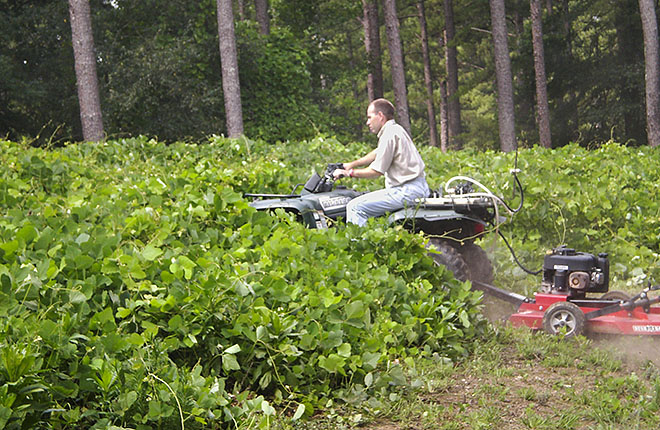Combined Control Tactics Remove Kudzu Faster
Kudzu was introduced with good intentions into the southeastern United States in the late 1800s. The invasive weed was first planted as a home ornamental, then as a forage crop for livestock, and finally, as a way to control soil erosion.
What we didn't know back then is that this native Asian plant doesn't control erosion; instead, it hides erosion while quickly gobbling up surrounding landscapes. Kudzu damages or kills other plants by smothering them under layers of leaves.
"Gullies still form underneath kudzu. You just can't see them," says plant pathologist Mark A. Weaver, at the Agricultural Research Service's (ARS) Biological Control of Pests Research Unit in Stoneville, Mississippi. "These gullies are evidence of large-scale, uncontrolled soil erosion."
Weaver and his colleagues are looking for quicker and more effective ways to control kudzu, which typically takes about 10 years of persistent herbicide applications to eradicate. Recently, they developed effective management programs, including one that uses an ARS-developed bioherbicide, mowing, and revegetation.
"We didn't just kill the kudzu and leave the soil open for erosion," Weaver says. "At the same time, we achieved a good establishment of a desirable native vegetation. In this case, we planted switchgrass."
Land infested with kudzu has no value, Weaver says. The plant disrupts native ecosystems, threatens natural resources, and inhibits use of forest land, particularly in Mississippi, where kudzu is pervasive.
"The faster you can get rid of kudzu, the faster you can start doing something positive with the land-establishing forestry, wildlife habitat, or recreational land," Weaver says. "We wanted to know if we could achieve an even higher rate of kudzu suppression and possibly eradicate it by combining successful control programs."
In his study, Weaver created research plots at three different infested sites. He repeated a series of treatment programs for 2 years. He tested the effectiveness of four different commercially available herbicides, either individually or in combination, and a bioherbicide treatment.
"We achieved a high level of suppression quickly and effectively on these mini plots after just 1 year," Weaver says.
In the second year, an even higher percentage of kudzu was killed using the herbicides, which are tolerated by some crops and are compatible with livestock grazing. "Results of the integrated herbicide programs were excellent: 99- to 100-percent reduction in kudzu," Weaver says.
With the treatment that involved applying a bioherbicide, mowing, and revegetation, Weaver was able to kill 91 percent of kudzu after 1 year and 95 percent after 2 years.
The research showed that a variety of methods, either alone or together, can rapidly kill kudzu. "But that's not to say that these treatments would work on all sites every year and that the kudzu cannot come back," Weaver says. Longer-term studies are needed to confirm that these high-level suppressions will last. — By Sandra Avant, ARS Office of Communications.
"Combined Control Tactics Remove Kudzu Faster" was published in the July 2016 issue of AgResearch Magazine.
Key Facts
- Kudzu is an invasive weed infesting the southeastern United States.
- Land covered with kudzu has no value.
- ARS demonstrated fast, effective ways to kill kudzu.
Full Story








